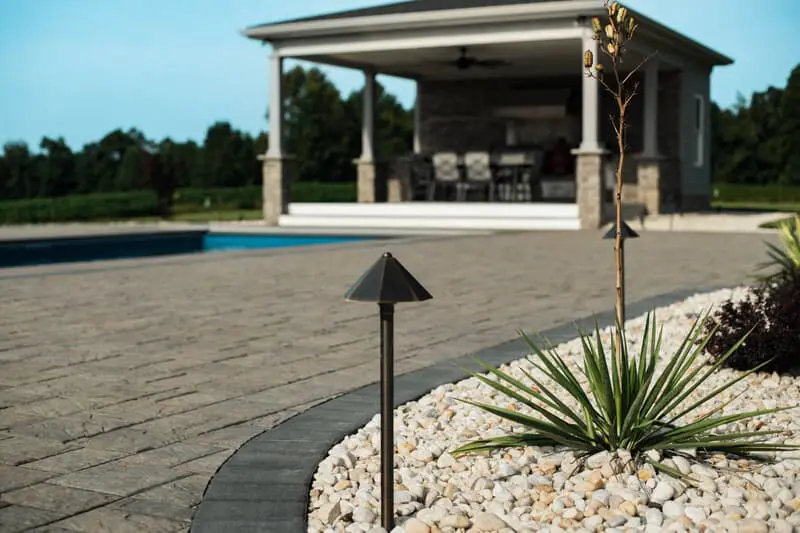Designing your hardscape requires the consideration of many different styles and materials. Two of the most prevalent materials are stamped concrete and pavers. When discussing these two options, I am often asked by homeowners what the primary differences are between stamped concrete and pavers. They are different in many ways, but I want to focus on 4 categories: texture, color, quality, and price.
Texture
After the concrete is poured, large rubber mats are laid down and tamped to stamp the pattern into the concrete. There are numerous stamp options to choose from; though each contractor typically has 3-4 favorite ones he will try to sell you. In my experience, many of these stamps create a surface that can be rather slippery when wet. Even some of the patters that look like they have enough texture to create more traction tend to be slippery under certain conditions.
Pavers also have many texture options. Some have a smooth top with rounded corners to give it a cobbled look. Others have a rough edge to create an antique appearance. In addition to these and many other textures, there are numerous sizes and patterns that can be created like running bond, basket weave, herringbone, or random patterns with anywhere from 3 to 9 different size pieces.
Color
When installing stamped concrete, dye powder is applied to the surface while the concrete is still wet in order to color the material; this is done before it is stamped with the pattern. There are many different colors you can get, so there is no shortage of options. However, the dye is only on the surface meaning it has a tendency to fade and any chip or scratch reveals the standard gray color of concrete underneath the dye.
When making pavers, the color or dye is mixed into the concrete before it goes into the mold. This way, the color is not just on the surface and will not disappear or significantly fade during years of weather and wear. In the unlikely event that the paver is chipped, you will still see the same color.
Quality
You might be wondering if it is all concrete, what difference does it make? To answer this, I need to explain a little about how concrete is made. When the concrete is mixed at a plant, the thick gray soup is poured in a drum on a back of a truck, delivered to the job, poured, and smoothed out. This is called poured concrete, and it creates a large slab that is typically 2-4 inches thick.
Over at the concrete paver manufacturing plant, the concrete is mixed and packed into the paver molds. Notice that I said “packed” instead of “poured” into the molds. After that, each tray of pavers is put into a large oven called a kiln. If you imagine placing a tray of cookies in the oven at home, you’ll have a pretty good idea how this process works. After the pavers are finished being made, they are stacked on pallets to be shipped to the job site.
Here are the two primary distinctions I want to make in regard to quality. First, the largest paver we install is about 2 square feet while a concrete slab can be any size. In order to demonstrate my point, let me ask; Have you ever tried to break a stick in half? If you take two sticks that are the same thickness but one of them is longer, the longer one is much easier to break than the shorter one. This is also the case with concrete. When you have one large slab, it will crack. It’s not a matter of if, it is a matter of when.
Secondly, the strength of concrete is measured in pounds per square inch (PSI). The average slab of poured concrete is strong enough to withstand 3,500 PSI once it has been cured. Because of the packing and baking process that concrete pavers go through, they are normally able to handle at least 9,000 PSI of force. That means that these pavers are extremely hard to break or crack in comparison to poured concrete.
Price
At this point, you probably agree with me that concrete pavers are the best option to create your patio or walkway. So why do many people still use stamped concrete? Simply put, stamped concrete is cheaper. Depending on the contractors who are giving you estimates, the price they give you for stamped concrete could be 50-70% the cost of pavers. On a large patio, this price difference could be thousands of dollars.
At the end of the day, it comes down to the experience and quality of work performed by the contractor. You can have an excellent product, but it could be ruined if not installed correctly; this is the same case with pavers. If not installed correctly, they could settle forming pot holes in your patio or grass and weeds might start growing between the pavers if the proper joint filler is not used. Regardless of what product you use, make sure you find a reputable contractor who is going to give you that perfect patio for your back yard.

